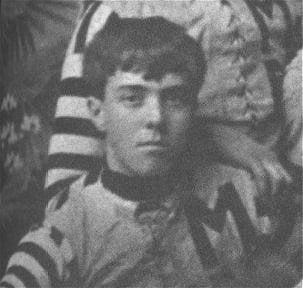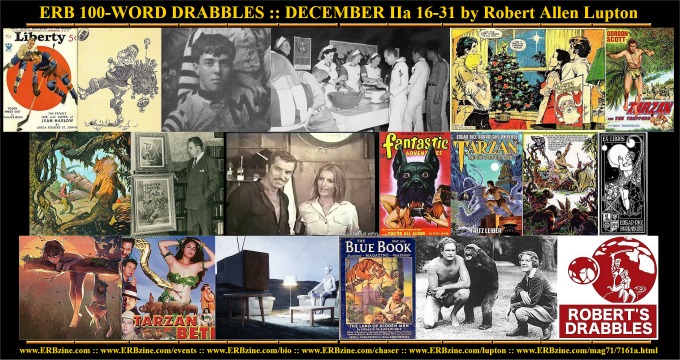
Official Edgar Rice Burroughs Tribute and Weekly Webzine Site Since 1996 ~ Over 15,000 Webpages in Archive Volume 7162a  |
ERB 100-Word Drabbles
DECEMBER II Edition :: Days 16 - 31
See Days 1 -15 at ERBzine 7162
by Robert Allen Lupton
With Collations, Web Page Layout and ERBzine Illustrations and References by Bill Hillman
POLYGAMY PROBLEM
December 16: On this day in 1933, Liberty Magazine published part six of their nine part serialization of “Tarzan and the Lion Man.”
“Lion Man” didn’t make the cover. Stockton Mulford illustrated the hockey story, “Youth Finds Out” by Wallace Irwin. Other stories in the issue included, “The Private Lives and Loves of Jean Harlow” by Adela Rogers St. Johns, “Tragic, Fistic, Antic,” by Beverly Hills (actually Frederick James Smith), and ‘Putting Towns in the Sky,” by Battell Loomis.
The drabble for today, “Polygamy Problem,” was inspired by “Tarzan and the Lion Man,” written by Edgar Rice Burroughs.
POLYGAMY PROBLEM
![]()
Henry became fascinated with the human, Rhonda Parrish, and decided she would become “Elizabeth,” and marry him. Tarzan asked, “Why would you want seven wives.”
“I don’t. I only want one. I’ll divorce the others.”
“Many men would like seven wives,” said Tarzan.
“Idiots. Seven wives means seven mothers-in-law.”
NEVER A WOLVERINE
December 17: On this day in 1895, “The Adjutant,” the Michigan Military Academy paper announced that Edgar Rice Burroughs had made the Academy’s championship football team. Indeed, Burroughs was listed as the team captain and quarterback. ERB drew a cartoon for the paper of Santa Claus as a quarterback ushering in a championship for the New Year as he kicked the old year to the side.
Burroughs was captain and quarterback for the team in 1893 and 1894. In 1896, when he was also the captain and quarterback, Burroughs had accepted a position with the academy as a geology instructor and Assistant Commandant. The team was always at the top of the Northeast Independent Conference under Burroughs’ leadership.
The drabble today, “Never A Wolverine,” was written by ERB for an unpublished autobiography.
NEVER A WOLVERINE
![]()
"We had an unusually good prep school team, cleaning up everything in our class and a number of teams that were out of our class. About the only teams that could beat us were such teams as Notre Dame and the University of Michigan, and at that we once held to a tie score the University of Michigan team. . .
One result was that I was offered flattering inducements to come to Michigan. The fact that two of my older brothers were graduates of Yale kept me from accepting, with the result that I never went to any college."
RED CROSS
December 18: On this day in 1941, it wasn’t even two weeks after Pearl Harbor and one of Edgar Rice Burroughs “Laugh It Off” columns was published in the “Honolulu Advertiser,” Hawaii’s Territorial Newspaper. A different edition of the column appeared in the “Honolulu Star-Bulletin” that day.
Both articles mentioned the Red Cross, but the article in the ‘Star-Bulletin” is effusive in his praise for the volunteer Red Cross workers, who on December 18, 1941 were still caring for the injured from the attack on Pearl Harbor and providing food and drink to anyone who needed it.
https://www.erbzine.com/mag11/1129.html
RED CROSS
![]()
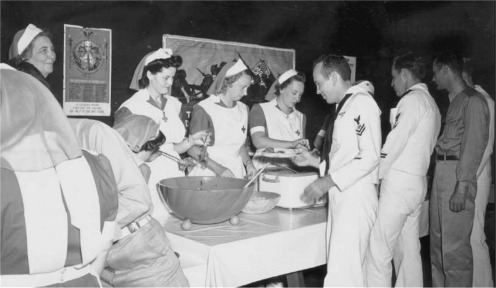
GOODWILL TO MEN
December 19: On this day in 1982, the Tarzan Sunday Comic Strip twelve part story, written and drawn by Mike Grell, was “Christmas With Meriem," It featured Tarzan, Korak, Jane and Meriem giving a Christmas greeting and a wish for world peace after decorating their tree.
It’s a week early, but Merry Christmas everyone. Here’s hoping for world peace, good health, and my hope that the new normal is better than 2020 and perhaps even a bit better than the old normal.
Mike Grell began his stint on the Sunday comics on July 19, 1981 with the story, “Return to Opar,’ and continued until February 6, 1983, concluding his run with the 12 part “Christmas with Meriem” storyline.
“Christmas with Meriem," and all of Mike Grell’s Tarzan daily and Sunday comics may all be read on the website ERBzine. “Christmas with Meriem” is located at
https://www.erbzine.com/mag29/2974.html
The drabble for today is “Goodwill to Men.” It’s based on Mike Grell’s Sunday comic and the Spirit of Christmas. As always it's inspired by Edgar Rice Burroughs.
GOODWILL TO MEN
![]()
“Beautiful, I never had a Christmas tree as a boy,
but nightly every tree was crowned with a parade of stars. Christmas was
just another day in the jungle.”
“What do you like best about the way we celebrate
Christmas?”
“I understand the symbolism and well-wishes. One would think that people who wish each other such happiness on this day, could behave the same way always.”
“True. Life would be better if the Christmas spirit lasted the full year.”
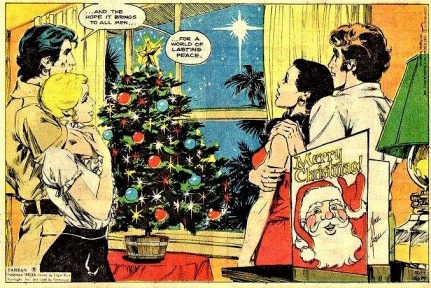
I KNOW MY RIGHTS
December 20: On this day in 1950, Walter White of Commodore Productions and Artists, Inc., entered an agreement with ERB Inc. for the Commodore Tarzan radio shows. All of these shows are available in various formats, including all 60 episodes at:
However, a sponsor was never signed and the series didn’t become a reality. The three episodes already filmed were edited together to create the feature “Tarzan and the Trappers”.
Today’s drabble, “I Know My Rights”, is inspired by Edgar Rice Burroughs, the 1950s battle over television rights to Tarzan, and by “Tarzan and the Trappers.”
I KNOW MY RIGHTS
![]()
“We know our rights. We got hunting and trapping permits. You can’t order us about.”
“Permits are meaningless here.”
“We ain’t stopping.”
Tarzan faded into the darkness, but over the next two days captured the three men. He hanged one upside down from a tree, placed one in a pit, and the last in a snare.
“I know your rights. You have the right to scream, the right to starve, and the right to be eaten. Good luck. Any questions.”
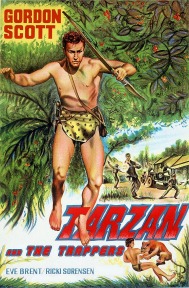
MOTIVATION ISN'T JUSTIFICATION
December 21: On this day in 1940, Edgar Rice Burroughs finished writing “Tangor Returns,” the sequel to “Adventure on Poloda,” the working title for “Beyond the Farthest Star.” He began the story on December 7 and finished it two weeks later. He wrote “Adventure on Poloda” earlier in 1940 (October 24th through November 5th).
While “Beyond the Farthest Star” was published in Blue Book Magazine in January of 1942, “Tangor Returns” did not see print until it was published in Canaveral Press’s “Tales of Three Planets” on April 27, 1964. The three planets referenced in the title are Poloda (“Beyond the Farthest Star” and “Tangor Returns,”) Earth (“The Resurrection of Jimber Jaw,”) and Venus (“The Wizard of Venus.”)
The story was reprinted by Ace and Ballantine / Del Rey in the United States and by Tandem in the United Kingdom. Jim Goodwin lists nine variants of Ace publications (some of the variants have more than one printing.) He lists only one edition of the book by Ballantine / Del Rey.
The Frazetta illustration is by far my favorite for the book.
The 2013 film, “Beyond the Farthest Star,” has absolutely no relation to Burroughs’ novel. Burroughs’ novel is a critic of war, communism, and fascism. Tangor arrives upon a seemingly utopian world, only to learn it is a nightmare – a complete world at war. Though he could have reasonably stood aside as an observer, he joins one side (the Unisians) and serves them with loyalty and selfless dedication.
Tangor did not choose sides poorly because the opposition (the Kapars) repress all human rights and freedoms. Burroughs styled the Kapars as an aggregate of the dictatorships existing in Nazi Germany and Stalinist Russia in 1940 when he wrote the stories.
The drabble for today, “Motivation Isn’t Justification,” was inspired by “Tangor Returns” written by Edgar Rice Burroughs.
MOTIVATION ISN'T JUSTIFICATION
![]()
The Kapars imprisoned him, but his intelligence allowed him to work his way into a position of authority, where he found himself responsible for ordering the very atrocities he’d hoped to prevent.
With that realization, he abandoned Kapar and returned to Unis. “I was becoming disgusted with my behavior. Calling it my job didn’t make it right.”
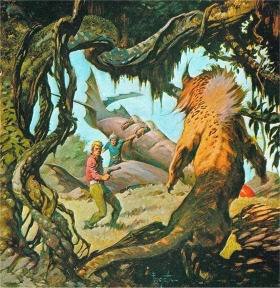
HAVE YOU READ IT
December 22: On this day in 1945, the Article “Little Known Works of a Well-Known Author” appeared in issue #215 of the fanzine “Fantasy Fiction Field.” The article was written by Burroughs historian, Darrell C. Richardson, B.A., B. D., Th.
Fantasy Fiction Field ~ December 22, 1945
LITTLE KNOWN WORKS OF A WELL-KNOWN AUTHOR
https://www.erbzine.com/mag64/6429.html
As of the day Richardson wrote the article, 57 of Edgar Rice Burroughs’ books had been published. Richardson points out that “Tarzan and the Champion,” Tarzan and the Jungle Murders,” and The Quest of Tarzan will be published in the not to distant future. (It took another 20 years before Canaveral would publish the three stories as “Tarzan and the Castaways.)
He mentions that “The Resurrection Of Jimber-Jaw,” “The Scientists’ Revolt” and “Beyond the Farthest Star” were only available in magazine form. Jimber-Jaw and Farthest Star were published in book form by Canaveral in 1964.
”The Scientists’ Revolt” aka ‘Beware” published in issues 42, 43, and 44 of ERB-dom in 197 and later in issues of the Burroughs Bulletin, but as a conventional book, one publication is fan publication by LOAHE Press, Dayton, Ohio in 2008. ERBville Press released two versions through the Create Space Independent Publish Platform.
The remainder of the article focuses on what Richardson calls the four rarest of Burroughs’ unpublished novels; “The Efficiency Expert,” “The Girl From Farris’s,” “Beyond Thirty,” and “Ben, King of Beasts.” Since the 1945 Richard Article, all four have been published in book form. The Girl From Farris’s was published in 1958 by the Wilma Company, House of Greystoke in 1964, and ERBville Press in 2002. Charter published a mass market paperback in 1979.
“The Efficiency Expert” was published twice by the House of Greystoke and once by Charter (1979). “Ben, King of the Jungle” was retitled “The Maneater” and a 300 copy edition was published by Fantasy Press in 1955, followed by the Science-Fiction and Fantasy Publications book “Beyond Thirty and The Man-Eater” in 1957 (great Gil Kane cover), and small reprint by Fantasy House in pamphlet format in 1974.
While all the stories that Richardson mentioned as rare in 1945 exist in more editions than they did at the end of World War Two, somehow it remains still true that what was rare at that time, is still rare today.
The drabble for today, “Have You Read It,” was inspired by the Darrell C. Richardson article and features my two old friends from New Orleans, Pat and John.”
HAVE YOU READ IT
![]()
“Pat, have you read “Beyond Thirty.”
“I read it as “The Lost Continent.” Ace paperback
with a Frazetta cover.”
“Not the same thing. Different title, different book.”
“John, that’s like saying that “Ben, King of Beasts”
and “The Maneater” are different stories.”
“Exactly, Pat. You’ve made my point.”
“No, I haven’t. I completely disagree.”
“Relax, Pat. It’s okay. I won’t tell anyone that you
haven’t read all the books.”
Pat almost wept. “Lord, help me.”
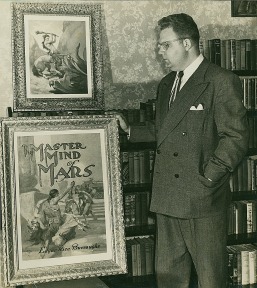
SHOW ME THE MONEY
December 23: On this day in 1968, the episode, “Jungle Ransom,” of the Ron Ely Tarzan television show was broadcast. The episode featured Fernando Lamas as Ramon Velesquez, Barbara Bouchet as Angela Fraser, and Ted Cassidy (Lurch) as Sampson.
This is one of Barbara Bouchet’s best television appearances and the over the top action in this episode makes it one of the best episodes of the series. Besides, Ted Cassidy plays a character named Sampson, come on, what more can you ask for.
Tarzan takes a boat to escort a convicted killer, Velasquez, to the authorities. Also on the boat is the wife of a man the killer's band is holding for ransom. She forces Tarzan at gunpoint to escort her with Velasquez to his camp where her husband is being held. Planning to kill everyone if necessary rather than deliver the ransom money, she has left the ransom money hidden behind, but Jai and Cheetah find it.
The drabble for today is “Show Me The Money,” inspired by the episode and by the writing of Edgar Rice Burroughs.
SHOW ME THE MONEY
![]()
She unhostered a gun and started firing. “I’ve got
your money right here.”
Everyone scrambled to hide. “You’ll release my husband
or I’ll kill you all.”
Velasquez said, “I can’t let people think a woman
beat me. She should just pay the ransom.”
Angela shouted, “It’s not about the money, you thief.”
Velasquez nodded to Tarzan, “Ah, my jungle captor.
When they say it’s not about the money – it’s only about the money.”
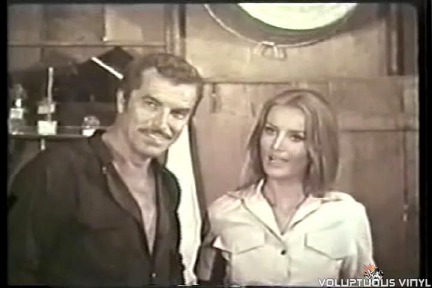
MODERATION
December 24: On this day in 1910, Fritz Leiber, author of “Tarzan and the Valley of Gold,” was born in Chicago, Illinois. Leiber was not only a writer of fantasy, science fiction, and horror, he was a poet, an actor, a playwright, and an expert chess player.
Leiber is best known for his stories about Fafhrd and the Gray Mouser, but over 17 novels and a couple of dozen collections have been published over the years. He won a Hugo and a Nebula award. He was the second recipient of the Gandalf Grand Master of Fantasy award and was awarded the World Fantasy Award for Life Achievement, the Science Fiction Writers of America Grand Master Award, the Bram Stoker Award for Lifetime Achievement, and was elected to the Science Fiction and Fantasy Hall of Fame.
While I was in San Francisco for work in the early 1980s, he agreed to meet a group of us for brunch. I don’t remember what he ordered, but I had Green Eggs and Spam. I recall that he mentioned that he wasn’t happy with the fourth film adaption of “Conjure Wife,” called “Witches Brew” aka “Which Witch is Witch.” Even though it was based on his novel, he wasn’t given any screen credit.
He recounted wonderful anecdotes and the hour he spent with us was over much too soon. He thanked us for brunch and said something to the effect that the story he was working on wouldn’t write itself and that he’d left the Gray Mouser in a horrible mess and needed to rescue him. We certainly weren’t ill met in San Francisco.
“Tarzan and the Valley of Gold” is available in hardcover from:
https://edgarriceburroughs.com/.../tarzan-and-the-valley.../
Today’s drabble, “Moderation,” was inspired by Fritz Leiber, “Tarzan and the Valley of Gold,” and as always, Edgar Rice Burroughs.
MODERATION
![]()
The assassin posed as a taxi driver and took Tarzan to a soccer stadium to be ambushed by a sniper. The gunman shot the driver by mistake. Tarzan chased down the sniper and crushed him with a giant Coca Cola advertising bottle.
The authorities asked Tarzan what happened. “Everyone knows that too much cola is bad for you.”
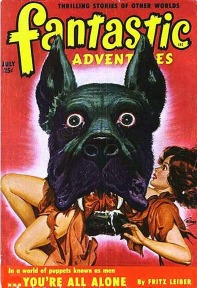 .
.
I CAN'T HEAR YOU
December 25: On this day in 1911, artist Burne Hogarth was born as Spinoza Bernard Ginsburg in Chicago, Illinois. Hogarth illustrated a number of art instruction books, but was most famous for his Tarzan newspaper comic strips. He illustrated the Sunday Tarzan comic strip for 12 years.
After 20 years away from the comics, Hogarth returned to the jungle and produced the graphic hardback book, "Tarzan of the Apes”, published by Watson Guptill in 11 languages. He followed that with “Jungle Tales of Tarzan.”
During his career, Hogarth was also a teacher, instructing students at the Manhattan Academy of Newspaper Art (Cartoonists and Illustrators School and later the School of Visual Arts.) He also taught at the Parsons School of Design, The Otis School and the Art Center College of Design in Pasadena, California. Who else but Hogarth could have produced entire books titled, “Drawing Dynamic Hands” and Dynamic Wrinkles and Drapery.”
Hogarth’s Tarzan Sunday pages have been reprinted twice to my knowledge. Once by Flying Buttress (NBM) in the 1990s and again by Titan Books in a five volume set during the last decade. Volume 5 of the Titan set included Hogarth’s Tarzan daily comic strips as well. Merry Christmas Burne Hogarth, and thank you.
The drabble for today is “I Can't Hear You.”
I CAN'T HEAR YOU
![]()
“I’m sure I will.”
Korak came in from the kitchen. “Mom, the figgy pudding
is gone and so is the fruit salad.”
The family searched and found Nkima, the monkey, asleep next to empty bowls. His fur was streaked with fig pudding.”
“Bad Nkima. Bad monkey. Shame on you,” said Jane.
Nkima put his hands over his ears and chanted, “Fa
la la la la, la la la la.
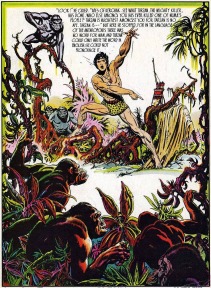
BOOKPLATE
December 26: On this day in 1892, Studley Oldham Burroughs, Edgar Rice Burroughs’ nephew and illustrator was born in Chicago, Illinois. By the early 1910’s Studley worked as a feature artist for the “Chicago Herald” before he moved to New York and drew for “Mothers Magazine.” He also worked for “The Los Angeles Tribune’s Sunday Fiction Magazine as an illustrator.
His wife died in childbirth in 1919 and Studley started an extended visit to Tarzana Ranch where he and Ed designed a nine-hole golf course, El Caballero Country Club. He designed Burroughs’ ‘ex libris’ bookplate about this time.
On February 19, 1931 Studley offered to illustrate his uncle Ed's books for the newly formed publishing company, ERB Inc. The payment schedule was $150 for a book jacket, $175 for a wrap-around jacket, and $75 for a frontispiece.
Studley illustrated four books before his personal issues made him too undependable to meet Ed’s publishing scheduling: “Tarzan the Invincible,” “Jungle Girl,” “Tarzan Triumph,” and “Apache Devil.” The vibrant colors and action make his illustration of “Apache Devil” one of my favorites.
For a detailed account of the the life of Studley Oldham Burroughs and several of his iillustrations - go to:
BOOKPLATE
![]()
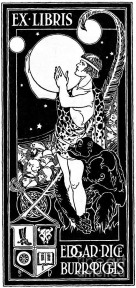
YOU EXPECTED A TEA PARTY
December 27: On this day in 1918, artist John Celardo was born in Staten Island, New York. Celardo drew both the daily and Sunday Tarzan newspaper comic strips from 1954 until 1968, producing a total of 4350 daily strips and 724 Sunday pages. In the early 1950s, the United Features Syndicate’s Celardo illustrated Tarzan daily and Sunday comics appeared in 225 newspapers in 12 different countries.
Celardo kept his Tarzan story lines fresh and contemporary by including current events. President Eisenhower once wrote him, “I find your work almost too perceptive.”
According to ERBzine, Celardo’s first daily strip was January 11, 1954 and the last was December 9, 1967. Russ Manning took over the next day. His first Sunday page was February 21, 1954 and the last was January 7, 1968.
https://www.erbzine.com/mag22/2293.html
When Celardo left Tarzan he took over “Tales of the Green Berets” from Joe Kubert and eventually developed a strip based on the Lassie television show. To my knowledge at no point did Lassie ever save Tarzan from falling into a well.
Today’s drabble, “You Expected A Tea Party” was inspired by Edgar Rice Burroughs and by Celardo’s propensity to include current events in his daily comics. At some level, the drabble is borderline political commentary about events that happened over sixty years ago, but I expect that’s the way Mr. Celardo would have liked it. He abhorred censorship.
YOU EXPECTED A TEA PARTY
![]()
“I read the news.”
“And you include current news in your Tarzan comic
strip, albeit thinly disguised. You’re aware of the Mau Mau Uprising.”
“I’m writing “Tarzan and the Jungle Revolt.”
“Please don’t mention the uprising until the British
resolve the rebellion one way or the other.”
“Indeed. Seems to me that the Mau Mau want the same
thing we wanted in 1776, the right to vote and to have a representative
government. I don’t see the problem.”

MAL B'ZAN THE MAGNIFICENT
December 28: On this day in 1923, George Merrick of the Reputable Pictures Corporation in New York City penned a letter to Edgar Rice Burroughs confirming three separate telegraph dispatches and a night letter dated December 24, 2020. The letter proposed that ERB write a new and original story, “The Daughter of Tarzan,” an original script under the authorship of Edgar Rice Burroughs. Burroughs was to be paid and advance of $5,000 as an advance against 10% of the net profits of the film.
Burroughs retained all publication rights to the story in word form.
On January 26, 1924, ERB replied by Telegram, “Ready to start story when you arrive. Suggest deferring action on director until then as I would like to have you consider a man I can get who is especially fitted to direct Tarzan picture.”
The deal fell through for some reason and the film was never produced. If ERB wrote a script, it must remain hidden somewhere in the treasure vaults of Tarzana, California. Perhaps, it is true and one day, someone will dust off the old manuscript, polish it up and we’ll see a new book and movie. Perhaps, not.
https://www.erbzine.com/mag20/2083.html
Today’s drabble is a non-existent conversation about the proposed script between ERB and his daughter, Joan. Call it “Mal B’zan the Magnificent.”
MAL B'ZAN THE MAGNIFICENT
![]()
“Please don’t. I’d suggest that name her Porter Greystoke. Her jungle name could be mal b’zan, that’s yellow hair if I remember my Mangani correctly.”
“Malbizan, I like it. I’ll check my notes once the contract is signed, the check clears, and I’m ready to start the story.”
“Don’t you trust the producer?”
“Not yet. All I have is his promise and $5000 of promise isn’t worth a dollar in the bank.”
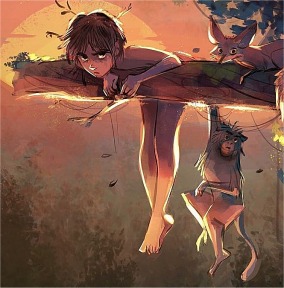

YOU DON'T NEED NO STINKING RIGHTS
December 29: On this day in 1931, Edgar Rice Burroughs submitted an article requested by “Writer’s Digest.” He titled the article, “Literary Rights,” and Writer’s Digest published it as “Protecting the Author’s Rights” in the 1932 edition of “Writer’s Yearbook.”
In 1915, copyrights didn’t anticipate radio rights, let alone television rights. No one considered payment for reruns or streaming channels like Prime Video or Netflix. Video Gaming rights were never imagined, nor were rights for pinball games or slot machines. There were no electronic readers. Comic books were a couple of decades away.
Copyrights, and contacts, publishing and otherwise, unless specifically stating otherwise, can be interpreted as that which is not forbidden is permitted. A loophole big enough to fly a 747 through, not that anyone thought about 747s in 1910. Who knows what rights aren’t being addressed in today’s copyright laws and publishing contracts. Publishing by beings from other worlds. Sensory productions and broadcasts where the watcher experiences the physical sensations of the actor.
Perhaps even construction of complete virtual worlds where the purchaser can finish a day at work in our world and spend the evening in Middle Earth, Barsoom, or Hogwarts. Wouldn’t it be precious to have dinner with a hobbit?
Burroughs had learned from experience to pay attention to these issues and the drabble for today is taken from his article “Protecting the Author’s Rights.” Let’s call it, “You Don’t Need No Stinking Rights.”
YOU DON'T NEED NO STINKING RIGHTS
![]()
Perhaps in my radio contracts, I’ll insist upon the reservation to me of the interplanetary rights. Why not? Radio rights and sound and dialogue rights would have seemed as preposterous twenty years ago; and with my intimate knowledge of conditions on other worlds, I, of all men, should anticipate the value of broadcasting Tarzan to the eager multitudes that swarm our sister planets.”

ONCE IN A LIFETIME
December 30: On this day in 1929, Edgar Rice Burroughs finished writing “The Dancing Girl of the Leper King.” The standalone novel was first published in Blue Book Magazine in five parts from May through September inclusive in 1931. Blue Book titled the story, “The Land of Hidden Men.” The cover of the first installment was by Laurence Herndon.
Edgar Rice Burroughs published the first edition, retitled "Jungle Girl," on April 15, 1932. Studley O. Burroughs did the cover art and six interior black and white plates.
In 1963, Ace Books produced a paperback of the story and used the Blue Book title, ‘The Land of Hidden Men.”
For more about the story and several illustrations go to:
Today’s drabble is “Once in a Lifetime,” and it was inspired by “The Land of Hidden Men,” also known as “The Dancing Girl of the Leper King,” and “Jungle Girl.”
ONCE IN A LIFETIME
![]()
“That’s not possible.”
“I am a doctor. My medicine will take fifty sunrises and you must stop eating mushrooms. The fungus will counteract my medicine.”
Lodivarman agreed. King concocted a worthless potion of fragrant herbs and wine. King knew Lodivarman had a rash from a mushroom allergy, not leprosy.”
In six weeks, the Leper King was cured. Fou-tan, King’s beloved said, “I thought mushrooms were edible.”
“Indeed, they are edible, but some are only edible one time.”
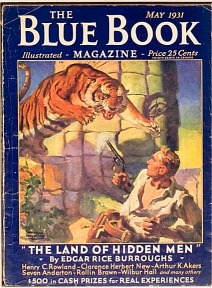
IT'S NOT YOU, IT'S ME
December 31: On this day in 1972, Joan Burroughs Pierce, actress and daughter of Edgar Rice Burroughspassed away after a long battle with cancer. Joan voiced ‘Jane’ in the 1932 Tarzan Radio series. She was married to James Pierce who played Tarzan on the same radio show and starred in the film, “Tarzan and the Golden Lion.” A detailed tribute to Joan Burroughs Pierce may be read at:
As a famous actor in a film made years later said, “Truth? You can’t handle the truth.”
Joan and Jim’s Tarzan of the Apes 1932 radio show began on September 12, 1932 and 286 episodes were produced. Seventy-seven episodes are available to listen to at:
Joan recounted the breakup in her diary and the drabble for today, “It’s Not You, It’s Me,” is taken from her dairy entries about that incident.
IT'S NOT YOU, IT'S ME
![]()
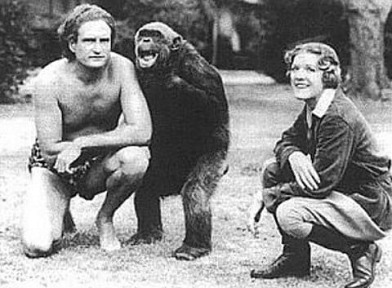
![]()
See
Days 1-15 at ERBzine 7162
![]()
DECEMBER IIa ILLUSTRATIONS COLLAGE
![]()

